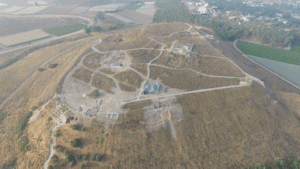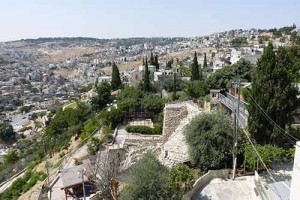YOSSI GARFINKEL
TEL LACHISH AND KHIRBET ARAI: SEARCHING FOR THE EARLY PHASES OF THE KINGDOM OF JUDAH
The Annual King’s Bible and Archaeology lecture

In the last 10 years significant new data has been unearthed in three of Professor Garfinkel’s excavation projects: Khirbet Qeiyafa, Tell Lachish and Khirbet Arai. Much information has been published on Khirbet Qeiyafa. The results from Tel Lachish and Khirbet Arai, however, are yet under analysis and so far hardly any data about the excavations has been published. The lecture presented the new results and their implications for understanding the early phases of the Kingdom of Judah.
MARTIN GOODMAN
AGRIPPA II: THE LAST JEWISH KING IN JERUSALEM
The Jewish king Agrippa II, the great-grandson of Herod the Great, played a pivotal role in the politics of Jerusalem during the decades leading up to the outbreak of war against Rome in 66 CE. During the war itself, he fought against the Jewish rebels alongside the Roman forces commanded by Titus, who in 70 CE presided over the destruction of the Jerusalem Temple and in 79 CE became Roman emperor. The lecture will examine evidence for Agrippa’s career in the archaeological and numismatic record as well as in contemporary literature, and the impact on his later reputation of his ambiguous status in Rome during the seventies CE, when his sister Berenice was known as Titus’ lover.
Martin Goodman is Professor of Jewish Studies in the University of Oxford, where he is a Fellow of Wolfson College and President of the Oxford Centre for Hebrew and Jewish Studies. He has written many books on Jewish and Roman history, including Rome and Jerusalem (2007).
DAVID JACOBSON
REFLECTIONS IN ANCIENT COINS OF THE MACCABEAN STRUGGLE AGAINST SELEUCID RULE
The Wars of the Maccabees are often cast as an archetypal struggle of an oppressed people to regain its national and religious independence. But the reality was by no means that simple. This long-running conflict was closely bound up with the internal vicissitudes of the Seleucid monarchy and the fate of the Maccabean leaders and their Hasmonean successors became intertwined with the holders of power in the Seleucid realm and their internecine wars Major episodes in this unfolding drama was illustrated by ancient coins as well as inscriptions and other archaeological evidence.
David M. Jacobson obtained a DPhil from the University of Sussex in Materials Science and a PhD in Classical Archaeology from King’s College London. He is an Honorary Research Fellow in the Department of Hebrew and Jewish Studies at University College London and, since 2009, editor of PEQ, the oldest journal of Levantine Studies. His publications include: Below the Temple Mount in Jerusalem (with Shimon Gibson, 1996), The Hellenistic Paintings of Marisa (2007), Herod and Augustus (with Nikos Kokkinos, 2009), Judaea and Rome in Coins, 65 BCE–135 CE (with Nikos Kokkinos, 2012) and Distant Views of the Holy Land (with Felicity Cobbing, 2015). His latest book is Antioch and Jerusalem: the Seleucids and Maccabees in Coins.
DR TED KAIZER
“AN EVEN MORE UNEXPECTED FIND” – THE SYNAGOGUE OF DURA-EUROPOS AND ITS PLACE IN LOCAL SOCIETY

The famous wall-paintings of the Dura-Europos synagogue are the only set to survive from antiquity. The unprecedented illustration of the Hebrew scriptures (in sharp contrast to the prescription of the Ten Commandments) suggest that Jewish communities living in the periphery of the Roman world, far away from their homeland, had much more leeway than the notion of an orthodox Judaism would suggest. This lecture located what has recently been referred to as “images of a competitive community” (by Tessa Rajak) in its local and regional context.
Ted Kaizer is Reader in Roman Culture and History at Durham University and author of The Religious Life of Palmyra. His research centres on the social and religious history of the Near East in the Late Hellenistic and Roman period. His present project is a study of the social patterns of worship at Dura-Europos, funded by a Major Research Fellowship of the Leverhulme Trust. He has widely travelled through the Middle East.
ZVI KOREN
THE ANCIENT COLOURS OF KINGS AND PRIESTS
Scarlet, crimson, and purple-dyed regalia were the privilege of ancient kings, emperors, Caesars, military generals, as well as high priests. These colours were obtained from fauna sources – entomological and malacological – and the purple pigment extracted from certain molluscan species produced the most commanding colourants. The “fashionable colours” of ancient peoples can best be studied by adopting an interdisciplinary approach to examine the chemical makeup of archaeological textile dyeings. The talk will showcase these rare colourants found on various archaeological objects, including a 4,000-year old blue-pigmented Egyptian burial wrapping; 3,000-year old purple pigments on Phoenician dyeing vats from Israel; a 2,500-year old purple-painted marble jar ascribed to King Darius the Great of Persia; 2,000-year old biblical argaman and tekhelet textile dyeings from Roman-Period Masada in the Judean Desert; and a 1,500-year old polychrome textile from Egypt.
Zvi C. Koren has been the Director of The Edelstein Center for the Analysis of Ancient Artifacts at the Shenkar College of Engineering, Design and Art in Ramat Gan, Israel, since the Center’s inception in 1991. He has served as the Chairman of the Department of Chemical Engineering at Shenkar, and until 1990 he was Professor and Chairman of the Department of Chemistry at The Cooper Union for the Advancement of Science and Art in Manhattan. He has published and lectured extensively on the scientific, historical, archaeological, and Judaic aspects of the natural colorants used in antiquity.
DR SAM MOORHEAD
EVER DECREASING CIRCLES – CAESAREA MARITIMA AS AN EPICENTRE OF THE LATE ROMAN “NUMMUS ECONOMY”

In 1982, Sam Moorhead was tasked with cataloguing over 2000 coins found on the beaches of Caesarea Maritima. This led to a lifelong interest in late Roman and early Byzantine bronze coins, called nummi. This lecture discussed how Caesarea was a key nodal point in a Mediterranean wide ‘nummus economy’ that lasted for well over a century.
Dr Sam Moorhead is the National Finds Adviser for Iron Age and Roman coins with the Portable Antiquities Scheme at the British Museum. He has worked as an archaeologist and numismatist on sites across Britain and the Mediterranean, including in Israel. He has been Chairman of the Palestine Exploration Fund, served on the Council of the Anglo-Israel Archaeological Society for many years, and has been Honorary Secretary of the Roman Society.
TESSA RAJAK
MASADA, FROM YADIN TO UNESCO
Just over fifty years since the conclusion of Yigael Yadin’s two seasons at Masada, this lecture offered a fresh evaluation of the spectacular excavation and its aftermath, in both international and Israeli perspective. The underlying ideology and methods of the dig were laid bare. Its achievements were given due credit, while an expert eye was cast over recent critiques, not all of them justified.
Tessa Rajak is Professor of Ancient History Emerita at the University of Reading, Senior Research Fellow of Somerville College, Oxford and a member of the Jewish Studies Unit at the Oriental Institute, Oxford. She has been Chair of AIAS since June 2015. Among her books are: Translation and Survival: The Greek Bible of the Ancient Jewish Diaspora; The Jewish Dialogue with Greece and Rome and Josephus: The Historian and His Society.
RONNY REICH
THE ROAD TAKEN: THE MAIN DISCOVERIES IN MY EXCAVATIONS OF THE CITY OF DAVID, JERUSALEM

Professor Reich, who excavated the City of David in Jerusalem on behalf of the Israel Antiquities Authority between 1995 and 2010, is AIAS special visitor to the UK.
The lecture explored some of his major finds, highlighting:
- Massive fortifications around the Kidron Valley spring that go back to the 18th century BCE.
- The nearby rock-cut ‘pool’ with a dwelling installed inside it. The under-floor fill included a huge number of fish bones, and the finds seemingly offer evidence of international trade in late 9th-early 8th century BCE Jerusalem.
- Part of the paved street leading up the hill to the Temple Mount, and the main sewer of the city of Jerusalem that runs under the street, both of the Herodian period. These were exposed by chance at the southernmost end of the City of David, following their partial discovery by Bliss and Dickie in the nineteenth century. The lecture discussed their relation to the layout of the city and to its final days prior to the destruction by the Romans in 70 CE.
Ronny Reich is Professor of Archaeology Emeritus at the University of Haifa and the current Chair of the Israel Archaeological Council. His latest books are: Miqwa’ot (Jewish Ritual Baths) in the Second Temple, Mishnaic and Talmudic Periods and Excavating the City of David, Where Jerusalem’s History Began, and he has authored more than 200 articles. He has been awarded the Austrian Cross of Honour for Science and Art, 1st Degree (2012).
PROFESSOR FRANCESCA STAVRAKOPOLOU
DIVINE WOMEN & BIBLICAL SCHOLARS
Ancient forms of goddess worship may seem a topic far removed from present-day debates about gender and the body. In this talk, however, Prof Stavrakopoulou explored the ways in which contemporary Western preferences about the female body, and related assumptions about gender, underscore scholarly debates about the nature and function of goddess worship in ancient Israel and Judah. She re-examined the status and value of goddesses in these ancient societies, and asked what the roles of these divine women can tell us about our own intellectual and cultural bias.
Francesca Stavrakopoulou is Professor of Hebrew Bible and Ancient Religion in the University of Exeter, UK. She is the author of a number of academic monographs, journal articles, and book chapters, most of which deal with the religious and social realities of ancient Israel and Judah, their (mis)representation in the Bible and their distortion in modern Western scholarship. Her work particularly employs anthropological, sociological, archaeological and cultural-critical approaches to the past and present. She appears regularly on TV and radio and has written for a number of British and international newspapers.
DR JONATHAN STÖKL
RECENTLY DISCOVERED HEBREW INSCRIPTIONS
 Dr Stokl presented some recently found inscriptions—and some recent scholarship on some less recently found inscriptions—from Israel and reflected on their importance for our understanding of the development of Hebrew script and scribal training in ancient Israel and Judah. The talk included comments on the Ophel inscription, Hezekiah’s seal and a recent study on the inscriptions from the Iron Age II fort at Tel Arad using computer based technology originally developed for police-work.
Dr Stokl presented some recently found inscriptions—and some recent scholarship on some less recently found inscriptions—from Israel and reflected on their importance for our understanding of the development of Hebrew script and scribal training in ancient Israel and Judah. The talk included comments on the Ophel inscription, Hezekiah’s seal and a recent study on the inscriptions from the Iron Age II fort at Tel Arad using computer based technology originally developed for police-work.
Jonathan Stökl studied theology at the Kirchliche Hochschule Bethel (Bielefeld) and the Humboldt University in Berlin before coming to study for an MSt in Hebrew and Jewish Studies at the Oxford Centre for Hebrew and Jewish Studies (‘Yarnton’). He stayed in Oxford to complete another MSt (Oriental Studies) and then a D.Phil (Hebrew and Assyriology). After finishing his doctorate he spent two years at St. John’s College Cambridge as Naden Research Associate in Divinity, and then joined the ERC project ‘By the Rivers of Babylon: New Perspectives on Second Temple Judaism from Cuneiform Texts’, first at UCL, and then at Leiden University, before joining King’s as a Lecturer in Hebrew Bible / Old Testament.

